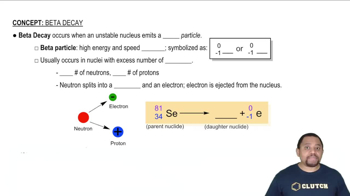Here are the essential concepts you must grasp in order to answer the question correctly.
Radioactive Decay
Radioactive decay is the process by which an unstable atomic nucleus loses energy by emitting radiation. This decay occurs at a characteristic rate for each isotope, often described by its decay constant, which is related to the half-life. Understanding this concept is crucial for calculating how the decay rate changes over time.
Recommended video:
Rate of Radioactive Decay
Half-Life
The half-life of a radioactive isotope is the time required for half of the radioactive atoms in a sample to decay. For Tl-201, the half-life is 3.042 days, meaning that after this period, half of the original sample will remain. This concept is essential for determining the time it takes for the decay rate to decrease to a specific value.
Recommended video:
Exponential Decay Formula
The exponential decay formula describes how the quantity of a radioactive substance decreases over time. It is expressed as N(t) = N0 * e^(-kt), where N(t) is the quantity at time t, N0 is the initial quantity, k is the decay constant, and e is the base of the natural logarithm. This formula is fundamental for calculating the time required for the decay rate to reach a certain level.
Recommended video:
 Verified step by step guidance
Verified step by step guidance

